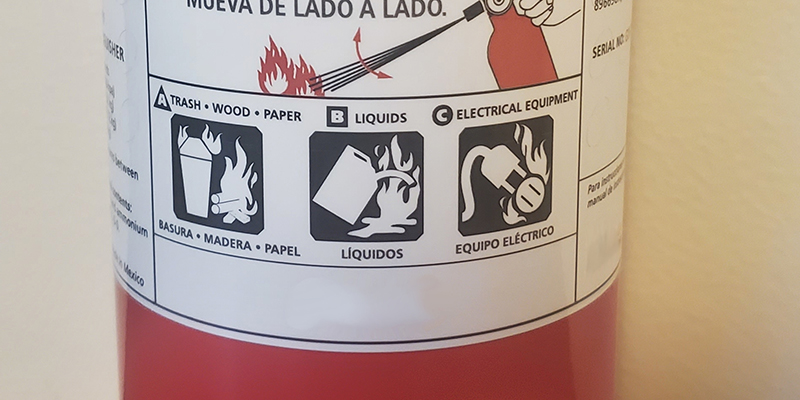Fire Extinguisher Ratings

Fire Extinguisher Ratings
Fire extinguishers are often the first line of defense when it comes to stopping fires while they are still small. A key component of successfully using an extinguisher is ensuring the type of extinguisher is a match for the type of fire. There is the risk of spreading a fire if you use the wrong extinguisher, this is one of the reasons we only recommend that only those who are trained use extinguishers. This blog addresses how extinguishers are classified to help make the right decision when both installing and using portable fire extinguishers.
Extinguishers are given a letter rating and some also have a number designation, which come from being tested to UL 711, Rating and Fire Testing of Fire Extinguishers. The letter on an extinguisher rating corresponds to the type of fire that extinguisher can put out while the number correlates to the extinguishing potential.
| Class A Fires
|
Fires in ordinary combustible materials, such as wood, cloth, paper, rubber, and many plastics. |
| Class B Fires
|
Fires in flammable liquids, combustible liquids, petroleum greases, tars, oils, oil-based paints, solvents, lacquers, alcohols, and flammable gases. |
| Class C Fires
|
Fires that involve energized electrical equipment. |
| Class D Fires
|
Fires in combustible metals, such as magnesium, titanium, zirconium, sodium, lithium, and potassium. |
| Class K Fires
|
Fires in cooking appliances that involve combustible cooking media (vegetable or animal oils and fats). |
Class A fires
Class A fires are those that involve ordinary combustible materials such as wood, cloth, paper, rubber, and many plastics. So, when you see a fire extinguisher with a class A rating then you know it can safely put out a fire made of ordinary combustibles.
This then leads to the question, well, what size fire extinguisher do I need. Class A fire extinguishers don’t exactly come in sizes, instead they are given a number designation that reflects the extinguishing potential. The higher the number the greater the extinguishing potential. Class A extinguishers need to be able to extinguish varying sizes of wood panels or wooden cribs in order to geta Class A rating. The wooden crib is made of 1 ½ in by 1 ½ in (38 mm by 38 mm) or 1 ½ in by 3 ½ in (38 mm by 89 mm) pieces of dry wood that vary in length depending on the number rating the manufacturer is going for. These pieces of wood are stacked into a crib, lit on fire and if the operator is successful in extinguishing the fire using the portable fire extinguisher, then it gets a certain number as well as the “A” rating. To give you a feeling for what these numbers actually mean; A 3-A rated extinguisher needs to put out a fire made of 144 pieces of 1 ½ in by 1 ½ in by 29 in wood. Class A extinguishers range from 1-A to 40-A
Class B fires
Extinguishers with a Class B rating are designed to be used on fires that involve flammable liquids and gases (think oil-based paint, alcohol, gasoline etc.). Class B rated extinguishers also have a number associated with them. That number is given to an extinguisher after it has been proven to be able to extinguish a certain size heptane fire. Heptane being one of the main components of gasoline. As an example of what exactly this means. A 10-B rated extinguisher has to be able to put out a fire consisting of 31 gallons of heptane in a 25 ft2 square steel pan.
Class C fires
Class C rated extinguishers can put out fires that involve energized electrical equipment. There are no numerical components for Class C ratings of extinguishers, we only care about the conductivity of the fire extinguisher. Basically, are you at risk of being shocked when using this extinguisher on energized equipment. To get the C rating the extinguishers are tested to see if any electrical current flows through them as they are discharged on energized electrical equipment. You won’t see an extinguisher with only a C rating, they will always have an A and/or B rating as well. (When electrical equipment is de-energized, extinguishers rated for Class A or B fires are used.)
Class D fires
Fires that involve combustible metals, such as magnesium, sodium, lithium, and potassium. There are no numbers associated with the Class D ratings of extinguishers. Extinguishers and agents for use on combustible metals fires are rated for the amount of agent and the method of application needed to control the fire.
Class K fires
Class K extinguishers are used on fires that involve cooking appliances that use cooking oils and fats (think deep fat fryer). There are no numerical components for Class K ratings because they are only tested on a single size fire source. This is tested by lighting a deep fat fryer fire and extinguishing it without any splashing of the oil or reignition.
Fire extinguishers often can come with a combination of ratings, for example it’s pretty common to see an ABC rated fire extinguisher that is ok to use on ordinary combustibles, flammable liquids and energized electrical equipment. For more information on requirements related to portable fire extinguishers, check out NFPA 10, Standard for Portable Fire Extinguishers. Also, check out our other fire extinguisher related blogs:
Important Notice: Any opinion expressed in this column (blog, article) is the opinion of the author and does not necessarily represent the official position of NFPA or its Technical Committees. In addition, this piece is neither intended, nor should it be relied upon, to provide professional consultation or services.
The post "Fire Extinguisher Ratings" appeared first on NFPA Today Blogs

